Table of Contents
This article will be broken up into 3 parts. We will first provide a brief introduction and key information that investors should be aware of pertaining to Syfe.
Next, we will delve into its investment methodology and lastly wrap up the article with a step-by-step account opening procedure, which should take no more than 10 mins of your time.
Part 1: Key information to know about Syfe before you get started
Syfe is one of the more than 10 different Robo-advisors available here in Singapore. Recently this digital wealth manager raised S$5.2m in seed funding, led by UK-based venture capital fund Unbound.
The company is founded by Dhruv Arora, previously a Portfolio Trader at UBS Hong Kong, and went on to become a Director and lead UBS’s exchange-traded funds (ETFs) efforts in the region.
Syfe is regulated by the Monetary Authority of Singapore (MAS) with a Capital Markets Services License for retail fund management after meeting all stringent standards set by MAS for financial and investment services companies.
Funds in the Syfe account are held in a Trust Account with DBS bank.
Investments in the Syfe account are held in a Custodian Account through Saxo Capital Markets.
Your money and investment assets are hence held separately from Syfe’s assets, which in layman’s terms if in the unfortunate event of Syfe undergoing liquidation, you will still have rightful claims to your monies.
Syfe charges an annual fee of 0.4% to 0.65% for your assets under management (AUM) with no transaction or brokerage fees. This is similar to most Robo-advisors and could be a good way of growing your portfolio through a Regular Savings Plan or (RSP) approach, particularly if the monthly capital contribution is small.
However, do note that their Global Portfolio offerings are mostly US-domiciled ETFs which will incur another layer of fees such as Portfolio expense ratio, dividend withholding tax, etc. I will not be regurgitating my concerns about US-domiciled ETFs in this article but according to my understanding, Syfe is gradually shifting some of its core US-domiciled ETFs into tax-efficient UCITS ETFs, which is a great thing.
With that, we wrap up some of the basic but important information you should be aware of. Let’s move on to its investment methodology.
Part 2: An Automated Risk-managed Investments (ARI) strategy
Syfe deploys what they termed as an Automated Risk-managed Investment Strategy or ARI for short, a proprietary investment methodology that combines two leading approaches – Global Market Portfolio (GMP) and Risk Parity Portfolio (RP).
Let’s talk in layman’s terms.
Simply put, Syfe’s investment methodology places the focus on risk management rather than investment return.
Instead of saying that an investor’s risk profile falls under the “Aggressive” category or “Balanced” category and therefore their portfolio structure should be 80:20 equity to bonds or 50:50 equity to bonds, Syfe, clearly defines the downside risk parameter.
Let’s say you have a maximum downside risk tolerance of 15% for your portfolio, Syfe will structure a portfolio structure that is “dynamic” to this risk tolerance ratio. How they go about doing it is all science and they have written a White Paper which I will not be elaborating on here.
Just note that if you set a maximum risk tolerance of 15%, there is a 2.5% probability that your losses could exceed 15%.
So, an investor might set a 15% risk tolerance and know with a 97.5% probability that no matter what happens to the market, his/her losses will not exceed 15%. Hence it gives you a medium-risk portfolio. There is always however that black swan event to consider, just like what we are experiencing at the moment with COVID-19.
A 15% risk tolerance might entail a portfolio structure (let’s use their REIT+ as an example) that consists of 80% REITs and 20% bonds at the current moment. This will dynamically change alongside the volatility nature of each asset class.
Let’s say that the Syfe algorithm detects a significant spike in REITs’ volatility. With the same portfolio structure of 80% REITs and 20% bonds, the maximum downside risk is now forecasted at 18%. As it now exceeds the +/-2% band range (i.e., there will be changes made to the portfolio structure if the risk exceeds the 13%-17% band range), Syfe will automatically do a portfolio rebalancing by selling your REITs and buying more Bonds to increase the defensiveness of the portfolio and reduce downside risk.
The new 15% risk profile will now consist of 65% REITs and 35% Bonds, for example.
You roughly get the drift that I am getting at.
The monitoring of the volatility nature of each individual asset category is done on a daily basis and the moment the algorithm detects a significant shift in risk profile, the rebalancing of the portfolio will be done immediately (i.e., max risk of an 80% REITs: 20% Bonds portfolio is now 18%, which exceeds the 2% corridor, as in our example, thus triggering an immediate rebalancing).
This is in a nutshell Syfe’s ARI methodology, explain in a layman term that I believe most of you are probably still able to comprehend. You can make changes to your risk profile (say from 15% to 10%) as and when you like and there will be an immediate rebalancing of portfolio done for you.
My thoughts on such an investment methodology
Syfe has demonstrated that its investment methodology has been able to beat its benchmark handsomely since 2004. Well, so has ALL the other Robo-advisors based on back-testing results. It doesn’t really count for much, to be honest.
Assuming that this Robo-platform is able to accomplish what it sets out to do, which is to CLEARLY define and manage the risk profile of an investment portfolio, then this I believe is a differentiating factor that Syfe has to offer.
I know with a high degree of certainty that if I set a 15% maximum risk drawdown, my portfolio downside will not cross 15% with a 97.5% probability rate. If I choose a Robo-advisor that advises a 60:40 equity to bond portfolio structure, there is absolutely no “certainty”, not even at the 90% or 80% probability rate that my maximum losses will not exceed 15%.
Hence Syfe is clearly suited for the more risk-averse investor who clearly knows what their maximum drawdown risk parameter is, for their minimum investment amount.
Syfe investment method is, however, not something that I will personally engage in a “logical” sense. Why so?
Using Syfe method, you will probably be over-weight risky assets at the peak of the market. This is when you wish to have a defensive portfolio. The nature of its investment methodology is that it will keep increasing the weighting of the riskier asset class in a bull market where asset volatility is declining.
Well in that sense, you can say that it is PASSIVE in nature and not TIMING the market. Hence this can be better for some beginners who want to start investing.
Only with hindsight do we know with 100% certainty that a market crash is coming and hence reduce risky assets and move into less-risky assets such as bonds while the market trends higher.
Hence, a Syfe constructed portfolio will likely experience the full negative impact of a market drawdown at the onset, given that it will be “overweight” risky assets at the peak.
What Syfe needs to demonstrate to alleviate investors’ concerns regarding such a negative market exposure, is how fast it reacts to this change in the volatility profile of the individual asset class to immediately rebalance investors’ portfolios. That is its beauty.
Say, for example, the current 15% downside risk Global Portfolio structure consists of 77.7% equity, 19.5% fixed income and 2.8% commodity. Will the algorithm have accurately identified the increasing elevated nature of volatility present in equities and start trimming the equity exposure over the past few days?
After 3 consecutive days of market sell-off, the rebalanced 15% Global Portfolio now consists of 54% equity, 36.5% bond, 6.4% commodity and 3.1% cash. With this new structure, the portfolio max risk is 14.7%. This portfolio likely avoided the max impact of the 27th Feb sell-off.
This is an area that requires further monitoring.
Introducing the REIT+ Portfolio
Syfe introduced its REIT+ portfolio recently. You can read more about it in this link.
I believe this portfolio structure will be pretty popular with Singapore investors, given our love for all things REITs.
Personally, I think it is one of the most affordable option to invest in a basket of selected high-quality REITs. The REIT+ portfolio has no minimum investment amount and fees start from 0.4%, going up to 0.65% for those with less than S$20k in AUM. This is all the fees you will incur as Syfe is not investing in REITs ETF which will incur another layer of fund expense fee.
This recurring fee structure is pretty similar to investing with the 3 REIT ETFs available in Singapore on a DIY-basis where the total expense ratio is somewhere in the region of 0.60%. However, one-off transaction fees (commissions, SGX Fees, etc) will be incurred.
For those looking at an RSP basis, with a capital monthly capital of <S$1,000, then investing with FSMOne into the REIT ETF offered by the platform could be an alternative cheap solution.
However, it does not come with the benefit of auto-rebalancing which a Robo-advisor is able to provide. And assuming that Syfe’s ARI does its job, there will be significantly less volatility associated with its REIT+ portfolio (due to the addition of bonds) vs. a pure 100% REIT portfolio exposure through REIT Exchange Traded Funds (ETFs).
However, do note that, unlike its Global Portfolio, Syfe’s REIT+ portfolio does not come with the option of defining the downside risk of this investment portfolio. The default and only option are one with a medium risk portfolio of 15%. This balances both total risk and yield, the latter currently sitting at approx. 4.25%.
With that, I wrap up Syfe’s investment methodology and REIT+ offering. I hope that I have presented a clear and non-biased view of Syfe’s product offerings.
Part 3: Step-by-Step account opening guide (<10 mins)
Opening a Syfe account is actually pretty fuss-free. 2 things u need before you get started. 1. Soft-Copy of your IC (front and back) and 2. Your online bank token to set up your FAST fund transfer.
Step 1: Choose your portfolio type (5 seconds)
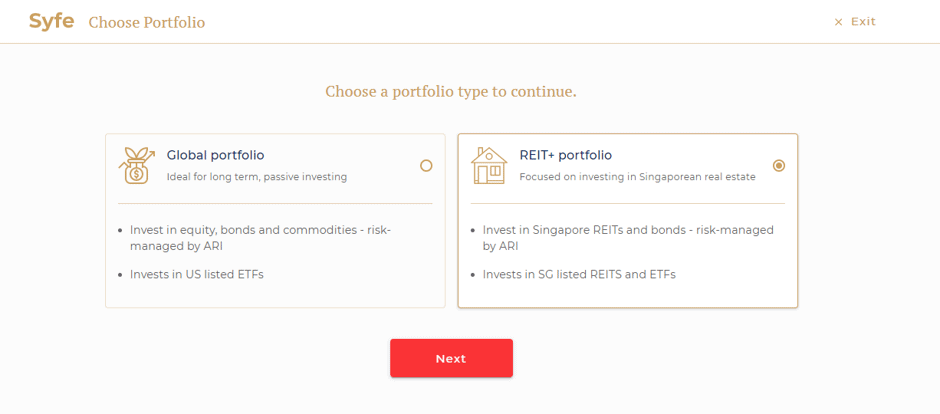
Step 2: Basic Introduction and risk profiling (10 seconds)
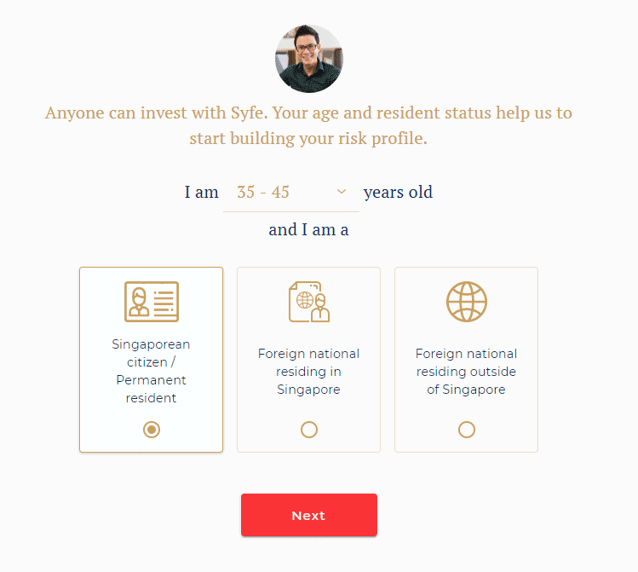
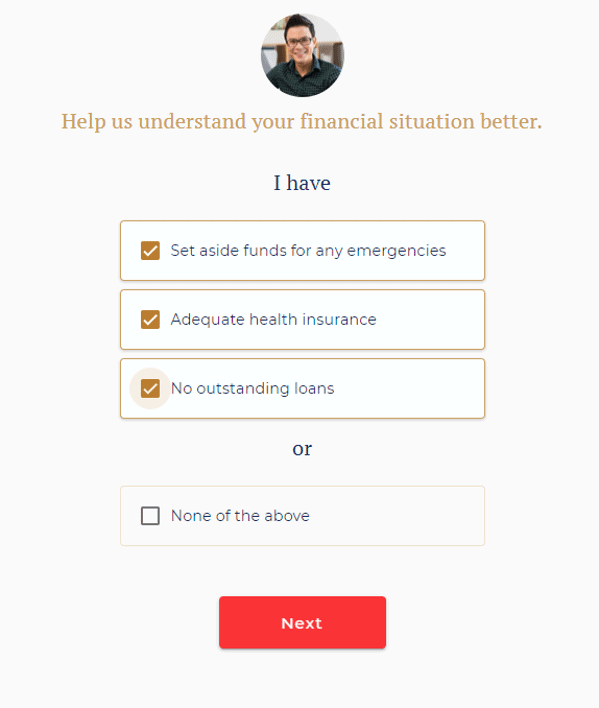
Step 3: Confirming your portfolio (2 mins)
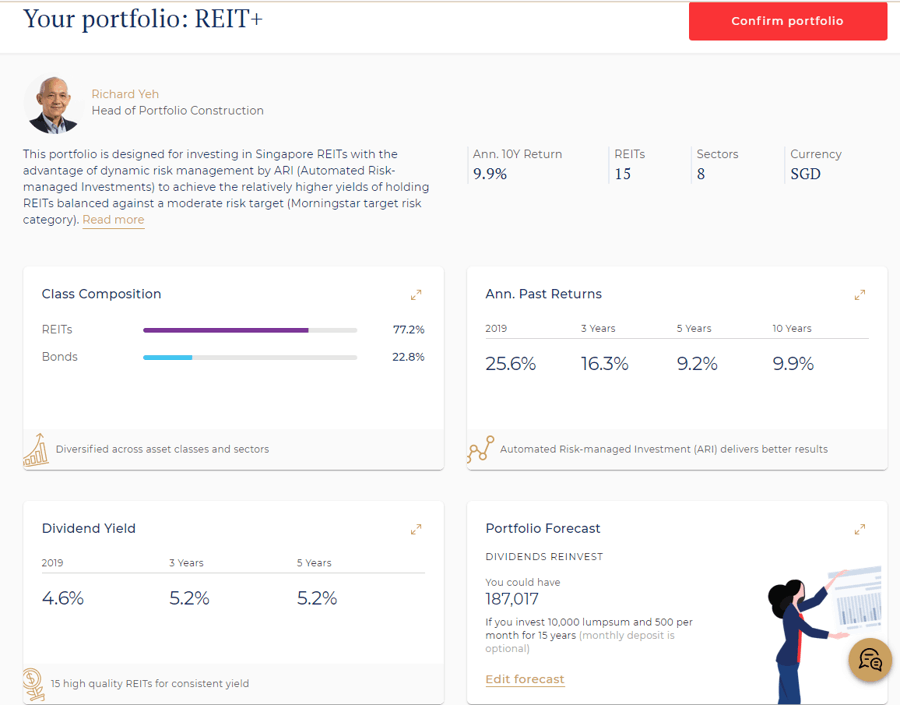
Here you might like to spend some time looking at the different tabs such as class composition, past performances, dividend yields, etc. Just click on the arrow.
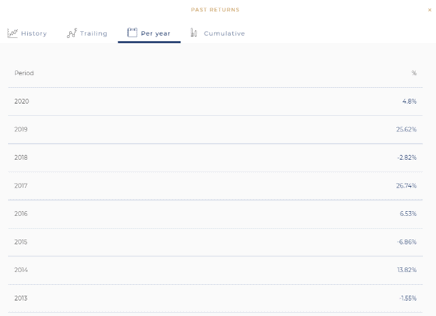
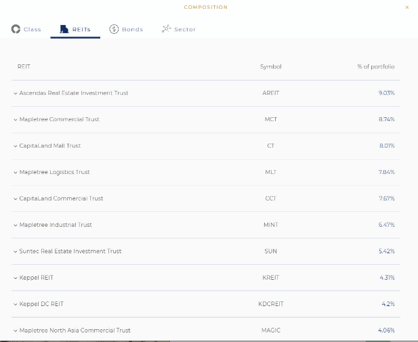
As highlighted, the REIT+ portfolio does not provide you the option to select your downside risk. The default downside risk for this portfolio structure is 15% which balances both risk and yield.
Step 4: Name your portfolio and select your dividend reinvestment option and funding amount (30 seconds)
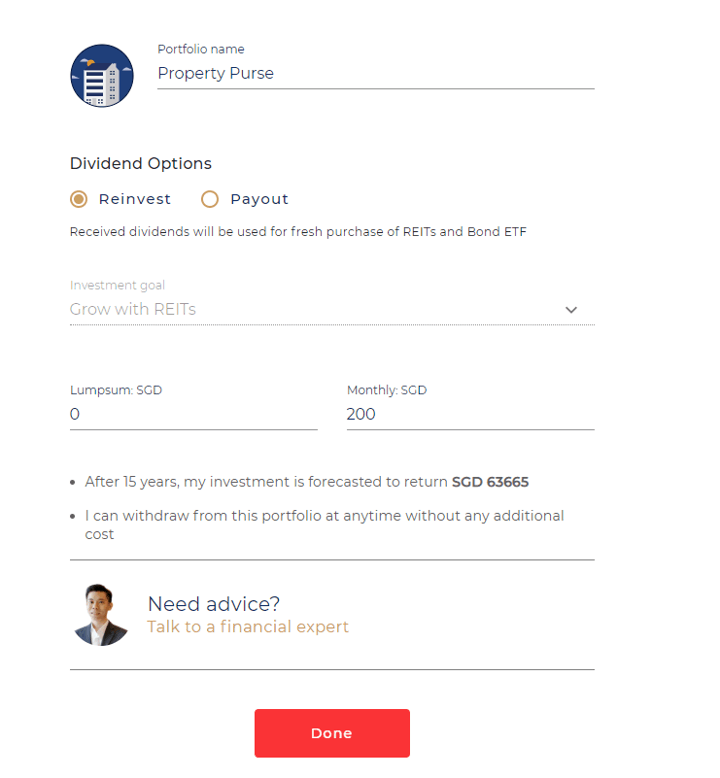
Don’t worry, you can make adjustments to your investment amount later.
Step 5: Inputting personal information (1 minute)

You will subsequently be required to do a mobile verification after inputting your personal information.
Step 6: Upload of IC (2 minutes)
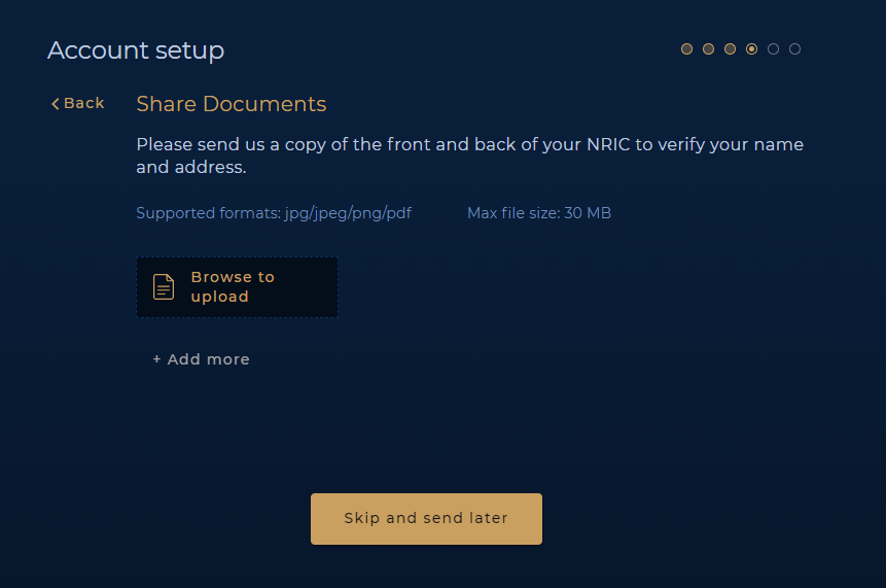
Depending on the speed of your internet connection, this could take some time.
After this, review and confirm that you have read the customer agreement and certify the W8BEN form.
Final step: Select the currency of your portfolio and initiate fund transfer (4 minutes)
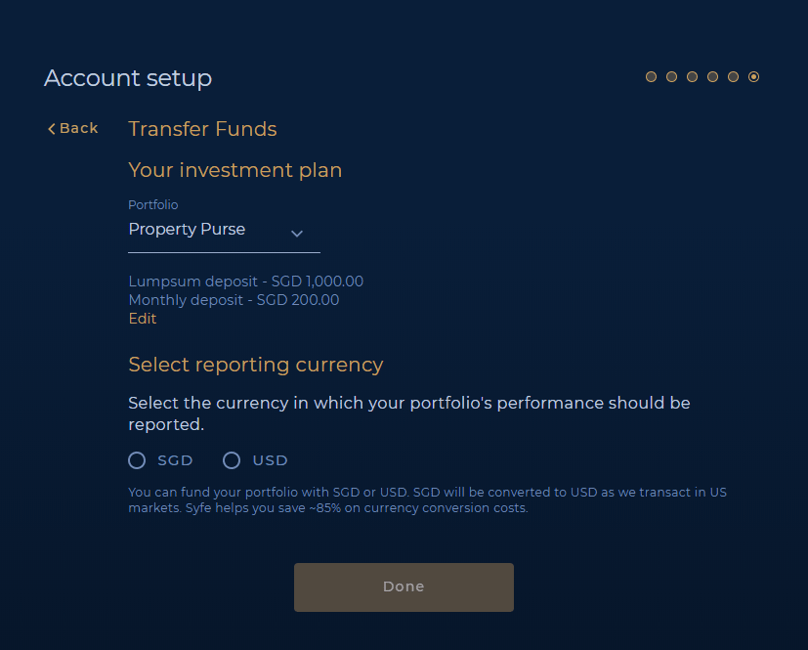
Here you might need the bank token of your bank to set the payment account for Syfe
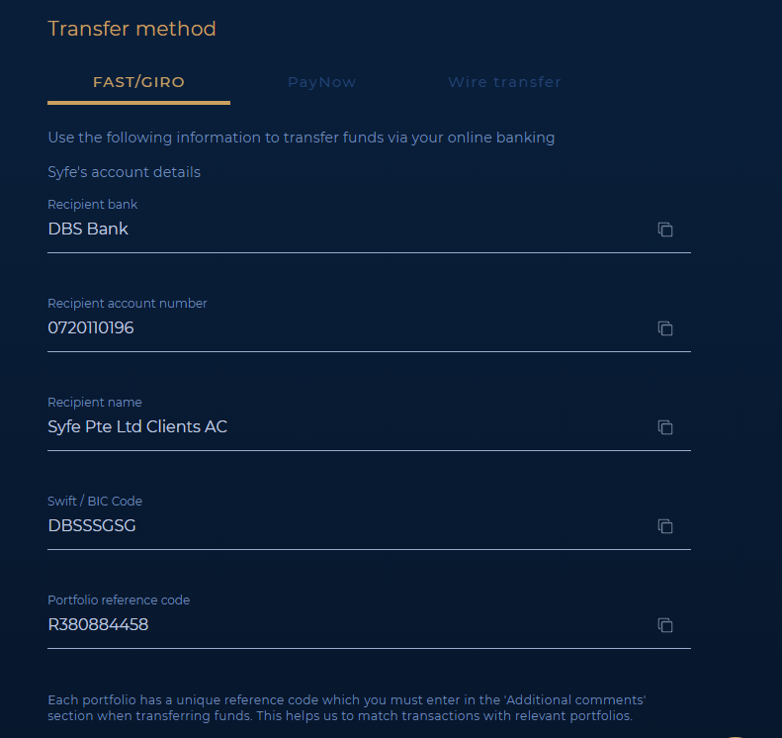
ALL DONE! The whole process takes less than 10 minutes.
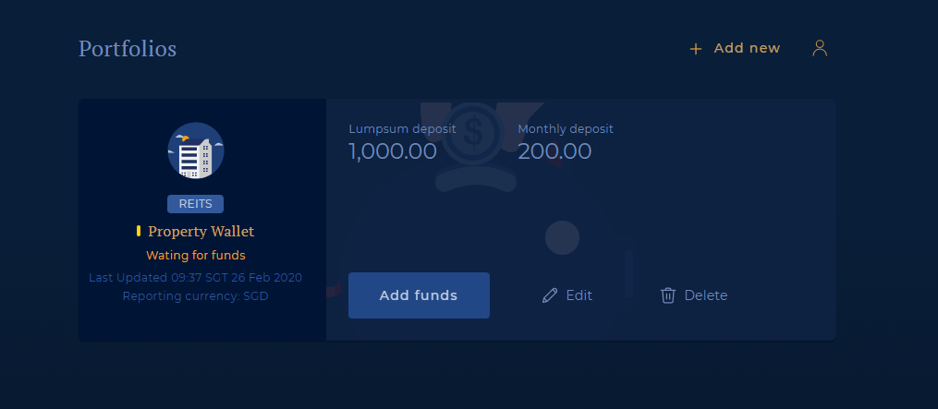
You can add a new portfolio easily in 2 simple steps or make changes to your default one. If you want to change the lump sum or recurring monthly deposit at this stage, you need to create a new investment portfolio as the “edit” function does not allow you to change the stipulated amount.
Do note that for monthly recurring deposits, there is no stipulated date where funds will be deducted. When you set up a recurring fund transfer from your bank (say on the 15th of each month), the moment the funds are received on the end of Syfe, it will immediately be invested).
Wrap UP
I hope I have presented the relevant information in an unbiased format with my own personal opinion for you to make an informed decision in your own investment journey. You might agree or disagree and the decision to invest with Syfe is totally up to you.
Syfe has kindly reached out to NAOF readers and you can choose to sign up through this affiliate link where I may receive a share of the revenue from your sign-ups.
Syfe Wealth
Fee waivers up to a cap of S$30,000 for the first 3 months, regardless of the amount deposited.
Syfe Trade
You will be entitled to a special S$70 in cash credit if you decide to deposit a minimum of S$2,000 and execute 1 trade. Both the funding of the account and trade must be done within 30 days.
Just click on the button below to sign up for your Syfe account today.
Whether you decide to use my link to get started on the Syfe Robo Advisor, you are invited to access my FREE Video Tutorial Robo Advisor Guide which will highlight to you the best Singapore Robo Advisors to use based on your investing style (passive, dividend income, international etc).
Disclosure: The accuracy of the material found in this article cannot be guaranteed. Past performance is not an assurance of future results. This article is not to be construed as a recommendation to Buy or Sell any shares or derivative products and is solely for reference only.

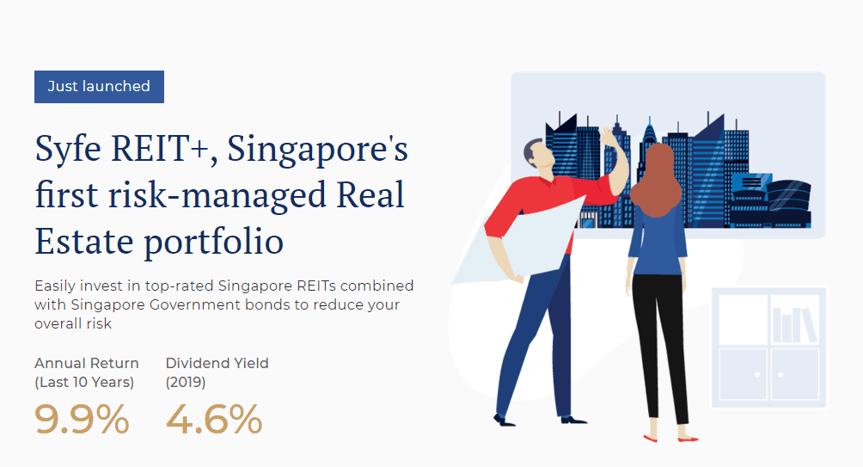








8 thoughts on “Guide to SYFE and how to open an account in less than 10 minutes”
i believe syfe’s lead time time is un-competitive.. from accounting opening to funds invested the markets may have moved. also, to a lesser degree their currency conversion fee is higher at 0.1%.
All in all.. they are late to the game, and other than portfolio products, i don’t see a clear second mover advantage or robustness with their mobile app, service product, or publications..
Good luck growing the aum or securing series b funding.. this space is getting crowded and some warriors will fall.
Hi Jay,
Thanks for stopping by and sharing your views.
I am not looking to defend Syfe but from my own personal experience, the account opening took less than 10 minutes and the fund transfer took 1 day. I am not sure if that can be considered slow, and whether or not a difference of one day really matters in the grand scheme of long term investing (which is what it should be for robo investing as you just cannot speculate on a basket of stock as easily as purchasing a single equity)
For me, i think they do have a unique proposition which is their ARI. Does it really work on a long-term basis… only time will tell.
Thank you for the detailed write up! Will be signing up using your referral link 🙂
Hi Cheng ken,
Glad you found it useful. thanks for dropping by